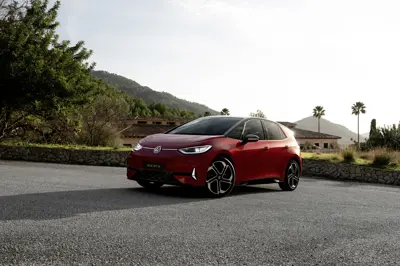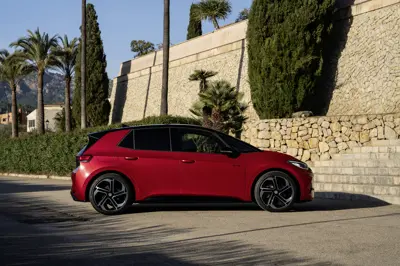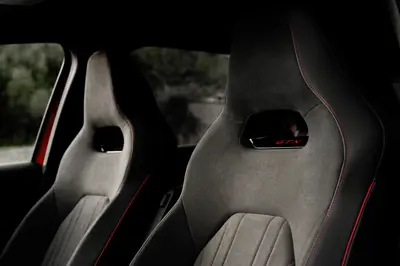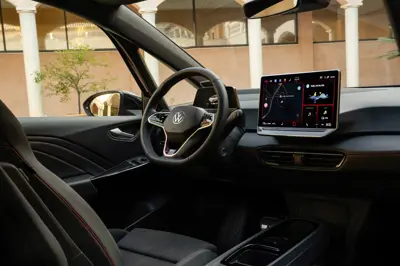Volkswagen ID.3 GTX
The Volkswagen ID.3 GTX is an all-electric hatchback offering a WLTP range of up to 600 km (373 miles). EVKX.net has all the details you need.
Volkswagen ID.3 GTX
We've organized this article into specific sections for easier navigation. Click the links below to jump to different areas or read on for the full article. Additionally, we offer an overview of the full specifications, an image gallery, detailed information about charging performance, and some online reviews. Our sections include:
Performance
The Volkswagen ID.3 GTX delivers a solid performance with a maximum power of 210 kW (286 hp / 282 bhp) and a total torque of 545 Nm (402 lb-ft). It accelerates from 0 to 100 km/h (0 to 62 mph) in 6 seconds and reaches a top speed of 180 km/h (112 mph), making it competitive within its class.
Battery, Range, and Charging
The high-capacity battery has a gross capacity of 84.0 kWh and a net usable capacity of 79.0 kWh, providing a 5.0 kWh buffer (6.0%) for battery protection. With a nominal voltage of 350 volts, the system is classified as a 400-volt battery system, aligning with industry standards.
According to the WLTP (Worldwide Harmonized Light Vehicles Test Procedure) standard, the vehicle's range is 600 km (373 miles), with an energy consumption rate of 13.2 kWh/100 km (3 mi/kWh).
For more details about the range, see real-world data and range listings on this model’s range and consumption page.
The vehicle supports fast DC charging with a maximum power of 185 kW. Charging from 0% to 100% takes approximately 46 minutes, while a typical 10% to 80% charge takes about 25 minutes with an average charging speed of 131 kW.
Considering an additional 5 minutes for each charging stop due to driving interruptions, the optimal charging range is from 3% to 56%. This results in an effective charging speed, including time lost, of 121 kW, with each charging session taking about 21 minutes and 45 seconds.
In a 1000 km challenge at a constant speed of 120 km/h (75 mph) with an assumed consumption rate of 21 kWh/100 km, the trip would take about 9 hours and 25 minutes, needing three charging stops from 2% to 58%, totaling 66 minutes of charging time.
Onboard Charger
The standard onboard charger supports up to 11 kW for Level 1 and Level 2 AC charging, allowing a full 0–100% charge in about 7 hours and 10 minutes with a standard home setup.
Charge Port
The location of the charge port is on the right rear side. This placement makes it easy to use charging stations that require backing up to connect.
Drivetrain
The Volkswagen ID.3 GTX has a rear-wheel drive system supported by one motor on the rear axle.
The motor used is Permanent Magnet Synchronous Motor.
Suspension
The front suspension is MacPherson Strut, and the rear suspension is Multilink. The standard suspension includes steel springs and hydraulic dampers.
The standard suspension has a fixed height and damping characteristics.
Ground clearance with this setup is 149 mm.
You can order Volkswagen ID.3 GTX with an alternative Sport suspension with DCC suspension.
The front suspension is MacPherson Strut, and the rear suspension is Multilink. The standard suspension includes steel springs and hydraulic dampers.
Steering
Progressive steering is standard on the Volkswagen ID.3 GTX, automatically adjusting the steering ratio based on speed for improved control and comfort.
Drive Modes
The Volkswagen ID.3 GTX lets the user select different drive modes that affect the car's handling.
The driver can choose between 3 modes:
- Eco: Balanced steering and efficient throttle.
- Comfort: Balanced steering and throttle.
- Sport: Dynamic steering and throttle.
Brakes
The Volkswagen ID.3 GTX uses disc brakes in the front for superior stopping power and heat dissipation, while drum brakes are employed in the rear for cost efficiency and durability. Drum brakes provide adequate performance for the rear wheels, require less maintenance, and integrate seamlessly with the vehicle's regenerative braking system. This combination ensures optimal braking performance and cost-effectiveness, aligning with the overall efficiency goals of the EV.
The front discs are 330 mm.
Regenerative Braking
The regenerative braking system in this model offers several modes to enhance efficiency and driving experience. The most efficient option is the Automatic Regeneration Mode, where the vehicle coasts when possible and employs regenerative braking to reduce speed as needed.
Manual regeneration is another mode, where regenerative braking is controlled by pressing the brake pedal. The brake system blends in physical brakes only when necessary.
Another option is the Regen on Accelerator Pedal mode where regenerative braking is activated when the driver eases off the accelerator pedal. This system allows the vehicle to slow down and recover energy without the driver needing to press the brake pedal, a feature often referred to as one-pedal driving.
If you lift away the foot completely the regen is at one fixed level. This can't be adjusted.
The maximum regenerative power is 170 kW.
Exterior
The Volkswagen ID.3 GTX, with dimensions of 4264 mm in length, 1809 mm in width, and 1564 mm in height, falls into the C-segment cars, also known as compact cars, strike a balance between size, performance, and affordability, making them versatile for a variety of drivers.
The Volkswagen ID.3 GTX is available in a total of 5 paint colors, including both solid and metallic options. Some of these paint options include two-tone paints where the roof and upper part of the body are painted in a different color, providing a distinctive and stylish look.
The Volkswagen ID.3 GTX offers multiple wheel options in different sizes, allowing you to customize your vehicle to suit your style and driving preferences. The available tire and wheel combinations include:
- 215/45 tires on 20" rims
- 235/40 tires on 20" rims
Narrower wheels improve consumption and provide a longer range, while wider wheels offer better traction and handling.
The car has four regular doors and a liftgate.
You can choose an option to have the liftgate electrically powered. You can also have the liftgate with a kick sensor, making it possible to open it by just kicking the foot under the tailgate.
There are two different roof options to select from.
The standard is just a regular roof.
As an option, you can order this model with a large panoramic roof extending over most of the areas from the front to the rear. This glass makes the car’s interior feel more spacious and bright, which can improve the mood and comfort of the occupant. It has an electric curtain that occupants can use to protect against the sun.
The windows from the B-pillar and back are tinted, which enhances privacy and reduces glare and heat from the sun, making the interior more comfortable for passengers.
Volkswagen ID.3 GTX
Interior
The interior of the Volkswagen ID.3 GTX is functional, with medium-quality materials used throughout. It includes a floating center console that creates an open space between the passenger and driver, providing convenient storage options. The overall design prioritizes practicality and ease of use.
Seats
The Volkswagen ID.3 GTX accommodates five passengers with two front seats and a three-seat bench in the rear.
First Row Seats
The Volkswagen ID.3 GTX offers a single type of front seat.
The following functionalities are available on the Top Sport seat:
- Fore-and-aft adjustment (electrically adjustable)
- Recline adjustment (electrically adjustable)
- Height adjustment (electrically adjustable)
- Seat cushion angle adjustment (electrically adjustable)
- Heating
- Memory
- Adjustable lumbar support (electrically adjustable)
- Adjustable thigh support (manually adjustable)
- Massage
- ISOFIX (standard for passenger seat)
Volkswagen ID.3 GTX
Second Row Seat
The second row features a standard three-seat bench with a 40:60 split, allowing each section to fold separately to increase cargo space.
Additional functionalities include:
- Height adjustable headrest
- ISOFIX (standard for outer seats)
Interior Storage
The Volkswagen ID.3 GTX provides ample interior storage solutions to enhance convenience and organization:
- Cupholders: Two cupholders are located in the front center console, with an additional two in the rear armrest.
- Glove Compartment: A spacious glove compartment is situated in the dashboard in front of the passenger, ideal for storing essential items.
Interior Lighting
The Volkswagen ID.3 GTX offers a range of interior lighting options designed to create a pleasant ambiance and enhance visibility.
- Multicolor Ambient Lighting: This feature extends across the dashboard, door panels, and footwell, providing a harmonious and inviting atmosphere. You can customize the colors to suit your mood or preference, adding a personal touch to your driving experience.
Climate System
There is one climate system available:
- 2-zone climate system: Supports different temperatures for the driver and passenger.
A standard heat pump is included, which can save significant energy that the EV would otherwise use for heating in cold weather.
Comfort Features
The Volkswagen ID.3 GTX includes several features to enhance comfort and convenience:
- Wireless Phone Charging
User Interface and Control
The control interface of the Volkswagen ID.3 GTX combines physical buttons, steering column stalks, and touchscreen displays to create a seamless and intuitive user experience.
This model features a dual-screen setup that separates driver information from infotainment functions.
Key screen details:
- Steering Column Display: A 5.0-inch screen mounted directly on the steering wheel column. This compact display shows essential driving information such as speed, range, and navigation prompts.
- Center Dashboard Touchscreen: A 12.9-inch display located at the center of the dashboard. It serves as the main interface for infotainment, navigation, and vehicle settings.
A optional head-up display projects key driving information—such as speed and navigation cues—onto the windshield for enhanced safety and convenience.
Volkswagen ID.3 GTX
Steering Wheel
The Volkswagen ID.3 GTX is equipped with a single type of steering wheel:
- Circular Steering Wheel: This steering wheel features integrated heating for added comfort during cold weather. It also includes haptic buttons, allowing you to control the infotainment system, adjust the volume, change music tracks, and manage other key functions with ease.
Mirrors
Both the exterior and interior mirrors use conventional mirror technology to provide a clear view of the area behind the vehicle.
This model comes equipped with voice control as standard, allowing you to manage various functions through voice commands.
Infotainment
The Volkswagen ID.3 GTX features an advanced infotainment system built on Android Automotive OS, a platform by Google specifically designed for vehicle dashboards. Enhancing this robust system, Volkswagen has integrated their own suite of applications, providing seamless navigation, comprehensive car settings, and much more.
Navigation System
The built-in navigation system uses detailed maps and offers advanced route planning, allowing you to define the target charge level at your destination or during charging stops. The system provides real-time traffic information ensuring an efficient and stress-free journey.
App Store
The infotainment system includes an App Store where you can download third-party apps to run natively on the car's screen without needing a connected phone. Available apps vary by market but include popular options such as:
Phone Mirroring
The Volkswagen ID.3 GTX supports Android Auto and Apple CarPlay, allowing you to mirror your phone's screen on the car's display. This functionality enables you to run apps like Google Maps or Waze directly from your phone.
Sound System
You can choose between two sound systems for the Volkswagen ID.3 GTX:
- Sound system: Features five speakers and delivers a maximum output of 140 watts.
- Harman Kardon sound system: Features eight speakers and delivers a maximum output of 480 watts.
Additionally, the model includes 4 USB-C connections as standard.
Mobile App
The Volkswagen ID.3 GTX comes with a dedicated mobile app, available for both Android and iOS devices, allowing you to manage and monitor your vehicle remotely. The app offers a wide range of features designed to enhance your driving experience:
- Locate Your Vehicle: Easily check the current location of your car.
- Preconditioning: Preheat or cool your car before you start your journey for optimal comfort.
- Lock & Unlock: Securely lock or unlock your car doors with a tap.
- Scheduled Charging: Plan and schedule charging sessions ahead of your trips.
- Adjust Charging Target: Set your desired State of Charge to start or stop charging as needed.
- Route Planning: Plan your route and send it directly to your car's navigation system.
Lights
The standard headlights use LED Matrix technology. LED Matrix is an adaptive system that splits the traditional single headlight beam into dozens of smaller rays that the light controller can turn on and off individually to un-light small areas in front. For enhanced safety, it includes corner lights that illuminate the side when turning.
The taillights use LED technology, ensuring both high visibility and energy efficiency.
Volkswagen ID.3 GTX
Advanced Driver Assistance Systems
The Volkswagen ID.3 GTX features a range of standard and optional advanced driver assistance systems (ADAS) designed to enhance safety and comfort.
Efficiency Assist: A Standard feature that helps drivers anticipate driving conditions and conserve energy.
Safety Systems
Anti-lock Braking System (ABS): Standard on the Volkswagen ID.3 GTX, this system prevents the wheels from locking during braking.
Electronic Stability Control (ESC): Standard on the Volkswagen ID.3 GTX, this system improves the vehicle's stability and handling during sudden maneuvers or on slippery road conditions.
Lane-Keeping Assist (LKA): Standard on the Volkswagen ID.3 GTX, this system helps prevent the vehicle from drifting out of its lane.
It also includes a Lane Departure Warning system to alert the driver if the vehicle veers out of the lane.
Front Cross Traffic Assist (FCTA) : Standard on the Volkswagen ID.3 GTX, this driver assist system that helps drivers detect oncoming traffic when crossing an intersection or turning left or right from a stopped position.
Forward Collision Warning (FCW): Standard on the Volkswagen ID.3 GTX, this driver assist system helps drivers avoid or mitigate frontal collisions.
Automatic Emergency Braking (AEB): Standard on the Volkswagen ID.3 GTX, this system autonomously applies the brakes to prevent or reduce the severity of a collision if the driver does not react in time.
Automatic Emergency Steering (AES): Standard on the Volkswagen ID.3 GTX, this system assists in avoiding collisions by automatically steering the vehicle in an emergency.
Blind-spot Monitoring (BSM) : Optional on the Volkswagen ID.3 GTX, this side assist system helps to detect traffic in blind spots.
Exit Warning: Optional on the Volkswagen ID.3 GTX, this system alerts occupants if there is a risk of opening a door into an oncoming object or person if there is a risk of hitting something.
Driving Automation
The Volkswagen ID.3 GTX offers driving automation at levels 1 or 2, depending on the equipment level.
With the Assistantpackage level 1 system, you get the following driving automation features.
With the optional Assistantpackage plus level 2 system, you get additional driving automation features to the ones listed above:
- Lane Centering Assist (LCA) /AutoSteer: keeps the car in your lane and slows down if needed in traffic. The system limits how long you can drive without touching the steering wheel.
Sensors & Cameras
This model uses cameras, radar, and ultrasonic sensors for its driver assist systems.
Up to three radar sensors, five cameras, and en 12 ultrasonic sensors monitor the vehicle’s surroundings.
Safety
The Volkswagen ID.3 GTX is equipped with multiple airbags to ensure occupant protection in the event of a collision. The airbag system includes:
- Front airbags for the driver and front passenger
- Side curtain airbags for both the first and second rows
- Side airbags for the driver and front passenger
- A front center airbag to prevent the driver and front passenger from colliding with each other during a side impact
Security and Access Technologies
The Volkswagen ID.3 GTX is equipped with advanced security features to protect you and your vehicle. These include:
- Keyless Entry and Start: With the standard keyless start and optional keyless entry, you can unlock and start the vehicle seamlessly without removing the key from your pocket or bag.
- Alarm System: An optional integrated alarm system monitors for unauthorized entry or tampering, providing alerts to help deter intrusions and enhance vehicle security.
Cargo Capacity and Towing Ability
The trunk offers a cargo capacity of 385 liters (13.6 CU FT). With the rear seat folded down, this expands to 1267 liters (44.7 CU FT).
The vehicle’s maximum weight is 2430 kg (5357 lbs), with a base weight of 1906 kg (4202 lbs). This allows for a maximum load of 524 kg (1155 lbs), including the driver and passengers. Note that some options may increase the base weight and reduce the maximum loading capacity.
This model is not available with a towbar. So, to pull a trailer, you must look at other models.
Availability & Pricing
The Volkswagen ID.3 GTX had its world premiere on 9/26/2024, with deliveries starting in February 2025.
This model is available in Europe and China.
Pricing
Pricing may vary depending on local conditions, incentives, and promotions. Below are the starting prices for select countries:
- 504,100 NOK (Norway)
Alternative Models
In the rapidly expanding EV market, EVKX.net has identified several alternatives to the Volkswagen ID.3 GTX that are worth considering based on features, specifications, and pricing. While these models may not be exact matches, comparing them could help you make a more informed buying decision:
Explore a detailed spec comparison of these models. Explore a detailed comparison of range and travel speed for these models.




